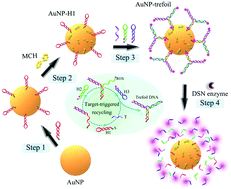Our official English website, www.x-mol.net, welcomes your feedback! (Note: you will need to create a separate account there.)
A dual signal amplification strategy for the highly sensitive fluorescence detection of nucleic acids.
Analyst ( IF 4.2 ) Pub Date : 2020-01-07 , DOI: 10.1039/c9an02183c Jingjing Zhang 1 , Chunyuan Song , Huiling Zhou , Juan Jia , Yinna Dai , Daxiang Cui , Lianhui Wang , Lixing Weng
Analyst ( IF 4.2 ) Pub Date : 2020-01-07 , DOI: 10.1039/c9an02183c Jingjing Zhang 1 , Chunyuan Song , Huiling Zhou , Juan Jia , Yinna Dai , Daxiang Cui , Lianhui Wang , Lixing Weng
Affiliation

|
The development of convenient sensing probes and strategies for the highly sensitive and specific detection of biomolecules is greatly significant for the diagnosis of diseases. Herein, a dual signal amplification strategy comprising target-triggered recycling and duplex-specific nuclease (DSN)-mediated amplifications was designed and proposed for a highly sensitive fluorescence assay of nucleic acids. In this strategy, three special hairpin structured single-stranded DNAs (i.e., H1, H2 and H3) were designed, and target-triggered recycling was operated on H1-modified AuNPs (i.e., AuNP-H1 probes) in the presence of target DNA, H2 and H3 to form trefoil DNAs on AuNPs (i.e., AuNP-trefoil). DSN was then incubated with AuNP-trefoil to cleave the double-stranded trefoil DNAs, causing the ROX molecules labelled on H2 and H3 to fall off the AuNPs, which resulted in the recovery of the previous AuNP-quenched fluorescence signal of ROX. The sensing mechanism was confirmed by polyacrylamide gel electrophoresis and fluorescence characterizations, and the sensing strategy was optimized from several aspects, such as the MCH blocking time of the AuNP-H1 probes (20 min) and the concentration (0.3 U) and immobilization time (15 min) of DSN. The practicability of the probes and the dual signal amplification strategy was investigated by a fluorescence assay of target DNA in human serum. A good linear calibration curve from 50 fM to 100 pM was obtained with a low detection limit of 47.68 fM. The sensing strategy showed good specificity, which could efficiently distinguish the target DNA from the single-base mismatched (SM) and completely unmatched (UM) DNAs. The recovery values ranging from 91.85% to 106.3% with the relative standard deviations (RSD) less than 7.30% also illustrated the good reliability of the proposed sensing probes and strategy. The AuNP-H1 probes and dual signal amplification strategy provide highly effective diagnostic agents and method for the analysis of disease-related nucleic acid biomarkers at the molecular level for early disease detection.
中文翻译:

一种双重信号放大策略,用于核酸的高灵敏度荧光检测。
用于生物分子的高灵敏和特异检测的便捷传感探针和策略的开发对于疾病的诊断具有重要意义。在本文中,设计并提出了包括靶标触发的循环和双链特异性核酸酶(DSN)介导的扩增的双重信号扩增策略,用于核酸的高灵敏度荧光测定。在该策略中,设计了三个特殊的发夹结构单链DNA(即H1,H2和H3),并在存在靶DNA的情况下对H1修饰的AuNP(即AuNP-H1探针)进行了靶触发的回收利用,H2和H3在AuNP上形成三叶DNA(即AuNP三叶)。然后将DSN与AuNP-三叶草孵育以切割双链三叶草DNA,从而使标记在H2和H3上的ROX分子从AuNPs上掉下来,从而恢复了ROX先前AuNP猝灭的荧光信号。通过聚丙烯酰胺凝胶电泳和荧光表征证实了其传感机理,并从多个方面对传感策略进行了优化,例如AuNP-H1探针的MCH阻断时间(20分钟),浓度(0.3 U)和固定时间( 15分钟)的DSN。通过人血清中靶DNA的荧光分析研究了探针的实用性和双重信号放大策略。在50 fM至100 pM的范围内获得了良好的线性校准曲线,并且检出限低至47.68 fM。传感策略显示出良好的特异性,可以有效地从单碱基错配(SM)和完全不匹配(UM)的DNA中区分出目标DNA。恢复值范围为91。85%到106.3%的相对标准偏差(RSD)小于7.30%,也说明了所提出的传感探头和策略具有良好的可靠性。AuNP-H1探针和双重信号放大策略为在疾病早期检测的分子水平上分析与疾病相关的核酸生物标记物提供了高效的诊断剂和方法。
更新日期:2020-02-17
中文翻译:

一种双重信号放大策略,用于核酸的高灵敏度荧光检测。
用于生物分子的高灵敏和特异检测的便捷传感探针和策略的开发对于疾病的诊断具有重要意义。在本文中,设计并提出了包括靶标触发的循环和双链特异性核酸酶(DSN)介导的扩增的双重信号扩增策略,用于核酸的高灵敏度荧光测定。在该策略中,设计了三个特殊的发夹结构单链DNA(即H1,H2和H3),并在存在靶DNA的情况下对H1修饰的AuNP(即AuNP-H1探针)进行了靶触发的回收利用,H2和H3在AuNP上形成三叶DNA(即AuNP三叶)。然后将DSN与AuNP-三叶草孵育以切割双链三叶草DNA,从而使标记在H2和H3上的ROX分子从AuNPs上掉下来,从而恢复了ROX先前AuNP猝灭的荧光信号。通过聚丙烯酰胺凝胶电泳和荧光表征证实了其传感机理,并从多个方面对传感策略进行了优化,例如AuNP-H1探针的MCH阻断时间(20分钟),浓度(0.3 U)和固定时间( 15分钟)的DSN。通过人血清中靶DNA的荧光分析研究了探针的实用性和双重信号放大策略。在50 fM至100 pM的范围内获得了良好的线性校准曲线,并且检出限低至47.68 fM。传感策略显示出良好的特异性,可以有效地从单碱基错配(SM)和完全不匹配(UM)的DNA中区分出目标DNA。恢复值范围为91。85%到106.3%的相对标准偏差(RSD)小于7.30%,也说明了所提出的传感探头和策略具有良好的可靠性。AuNP-H1探针和双重信号放大策略为在疾病早期检测的分子水平上分析与疾病相关的核酸生物标记物提供了高效的诊断剂和方法。



























 京公网安备 11010802027423号
京公网安备 11010802027423号